 |
Focus features two in-depth reviews each month of fine art, architecture and design exhibitions and events at art museums, galleries and alternative spaces around Japan. The contributors are non-Japanese art critics living in Japan. |
|
|
 |
 |
 |
A New Beginning and the End of the World: Photo Museum Reopens with Hiroshi Sugimoto's "Lost Human Genetic Archive"
Alice Gordenker |
 |
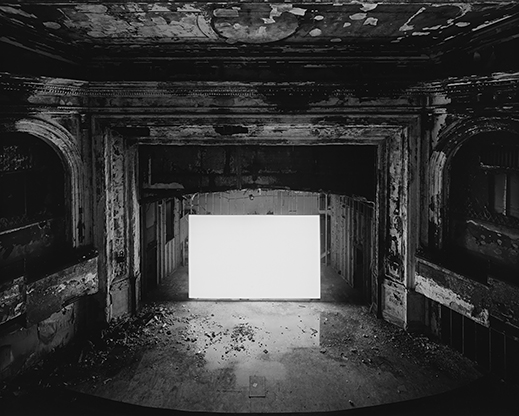 |
|
Franklin Park Theater, Boston. The ruins of an abandoned theater photographed only by the light emitted during a full-length screening of Akira Kurosawa's 1950 movie Rashomon. 2015 gelatin silver print. © Hiroshi Sugimoto/Courtesy of Gallery Koyanagi |
You'd think a brighter theme might be in order for a grand return, but Tokyo's photography museum reopened on 3 September with an exhibition that questions the very future of mankind. In Lost Human Genetic Archive, which runs through 13 November, New York-based artist Hiroshi Sugimoto presents three bodies of work that together explore the decay and demise of civilization. Occupying two floors, the show offers up Sugimoto's view of history, and it's a dark one indeed.
Nevertheless, the high-profile exhibition represents a shiny new beginning for the museum, which just completed an extensive renovation. The venerable institution, which celebrates its 20th anniversary this year, is back after a two-year hiatus with a brighter look, improved facilities, and even a new name in English. It's now called the Tokyo Photographic Art Museum, or TOP Museum for short, a rebranding intended to emphasize that the museum embraces all forms of photographic media, including moving images. The Japanese name remains the same -- Tokyo-to Shashin Bijutsukan.
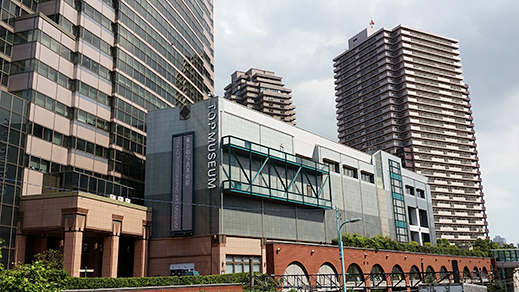 |
|
The Tokyo Photographic Art Museum. Photo by Alice Gordenker |
When it opened in 1995, the Tokyo Metropolitan Museum of Photography (as it was previous known in English) was the first public gallery in Japan devoted to photography. This was a time when it was almost unheard of for a Japanese art museum to exhibit photographs. Over its first two decades, the museum did a lot to help legitimize the medium as art, in part by showcasing world-class Japanese photographers including Eikoh Hosoe, Ikko Narahara, Nobuyoshi Araki, and Daido Moriyama. It also supported developing artists, providing exposure at key times: Yuki Onodera and Tomoko Yoneda are two photographers who received mid-career boosts through solo exhibitions there. Curators took a broad view of photography as art, promoting genres that tend to be overlooked, including fashion, travel, and alpine photography.
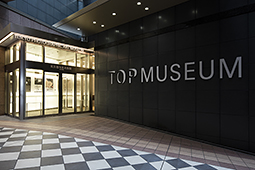 |
|
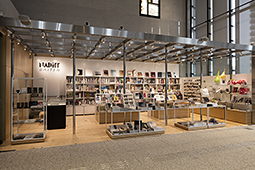 |
|
Welcome changes: a new doorway makes the first-floor entrance easier to find, and the museum shop, which stocks a large number of photography books, is now in a more prominent position on the second floor. |
Yet, as these good works were progressing, the physical plant began to wear around the edges, and exhibition and storage facilities fell behind advances in technology. So in September 2014, the staff and collection moved out and construction crews moved in. The dated carpeting in the second- and third-floor galleries is gone, replaced by wooden flooring, and the modular walls are now larger to accommodate bigger works. The exhibition rooms are equipped with state-of-the-art LED lighting and automated environmental-control systems, which matters because photographs are easily damaged by light and changes in temperature and humidity. To improve the visitor experience, a second elevator was added and restrooms are now fully accessible.
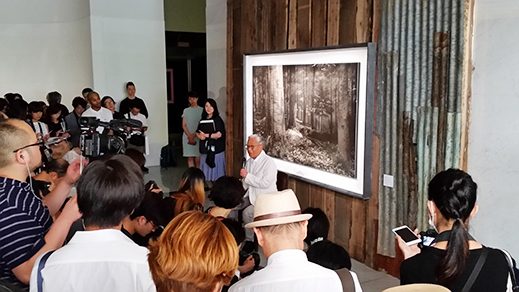 |
|
Seated in front of one of his Diorama photographs, Hiroshi Sugimoto answers questions at a press event that attracted nearly 200 reporters. Photo by Alice Gordenker |
For its first post-renovation exhibition, the museum tapped Sugimoto, whose fame has spread beyond photography as he took on projects in architectural design and even classical Japanese puppetry. Yet he is probably still best known for huge yet minutely detailed photographs, made with large-format cameras and long exposure times. Those familiar with Sugimoto's work will recognize prints from earlier series, including On the Beach (of car parts washed up on a shore in New Zealand) and Dioramas, in which the old-fashioned, three-dimensional recreations of nature in natural history museums come out looking eerily real.
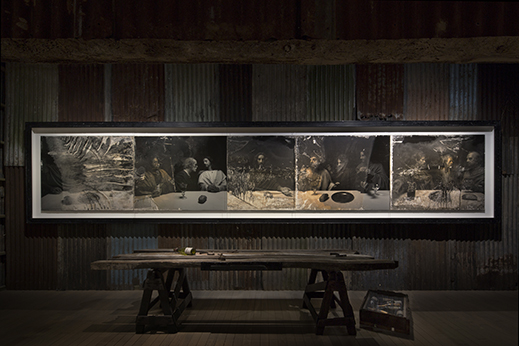 |
|
The Last Supper: Acts of God (Sandy) (1999). 2015 gelatin silver print staged with various objects. © Hiroshi Sugimoto/Sugimoto Studio |
Sugimoto is an avid collector of historical artifacts, including war memorabilia. Now in his late sixties, and obviously pondering the many ways in which humanity destroys itself, Sugimoto has set out in a new direction: grouping objects from his collection with his own photographs to express ideas he says he cannot put into a photograph alone. For the current exhibition, which begins on the third floor, Sugimoto created partitions of weathered boards and rusted corrugated steel panels in which he set up 33 narratives recounting the end of the world. Whether war, pandemic, or robot revolt, the stories are told largely through objects and handwritten Japanese texts. It's tough to find the narrative thread and harder to follow it, even when referring to the provided handout.
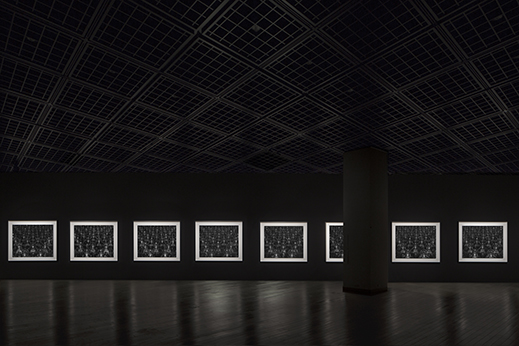 |
|
Installation view of Sea of Buddha (1995). © Hiroshi Sugimoto/Sugimoto Studio |
It's a relief to leave the clutter and demands of this section and proceed to the relative calm of the second floor. Here, Sugimoto shares for the first time his Abandoned Theater series, for which he laboriously scouted out the ruins of cinemas and opera houses in cities across the United States. Most were derelict and long without power. To capture the decay inside, he brought in generators and played a carefully selected film, using the light emitted as his only illumination for an exposure time that lasted as long as the film.
Also on the second floor, around a partition, is the third and final section of the show: a soothing installation of nine prints from Sugimoto's 1995 series Sea of Buddha, combined with a tiny five-ring pagoda. It took seven years of negotiations with Kyoto's Rengeo-in temple before Sugimoto was permitted to bring his camera into its main hall, which is known as the Sanjusangendo. This long and narrow structure, built in the 12th century by the Emperor Go-Shirakawa as a prayer for salvation, is filled end to end with a row of one thousand life-size statues of the Thousand Armed Kannon. To capture these images as they must have been seen before the advent of electric light, Sugimoto used only the light of the early-morning sun as it slanted into the temple. The results are sublime and Sugimoto at his technically brilliant best. At the end of a doomsday exhibition, this quiet finale does leave one with a little hope for the world.
Photos courtesy of Tokyo Photographic Art Museum unless otherwise noted. |
 |
| Hiroshi Sugimoto: Lost Human Genetic Archive |
| 3 September - 13 November 2016 |
| Tokyo Photographic Art Museum |
| |
Yebisu Garden Place, 1-13-3 Mita, Meguro-ku, Tokyo
Phone: 03-3280-0088
Hours: 10 a.m. to 6 p.m. (8 p.m. on Thursdays and Fridays). Closed Mondays except when Monday falls on a national holiday, in which case the museum is closed the following day, and 29 December to 1 January.
Access: 7-minute walk from the East Exit of Ebisu Station on the JR Yamanote Line or a 10-minute walk from Exit 1 of Ebisu Station on the Tokyo Metro Hibiya Line. Follow the Sky Walk moving sidewalk to Yebisu Garden Place. |
|
 |
 |
Alice Gordenker
Alice Gordenker is a writer and translator based in Tokyo, where she has lived for more than 17 years. For over a decade, she penned the "So, What the Heck Is That?" column for The Japan Times, providing in-depth reports on everything from industrial safety to traditional talismans. She translates and consults for museums, and has a special interest in making Japanese museums more accessible for visitors from other countries. |
|
 |
|